Back to Page
Amazon PPC
7 Tips To Optimize Your Amazon PPC Keyword Bidding Strategy
7 Tips To Optimize Your Amazon PPC Keyword Bidding Strategy
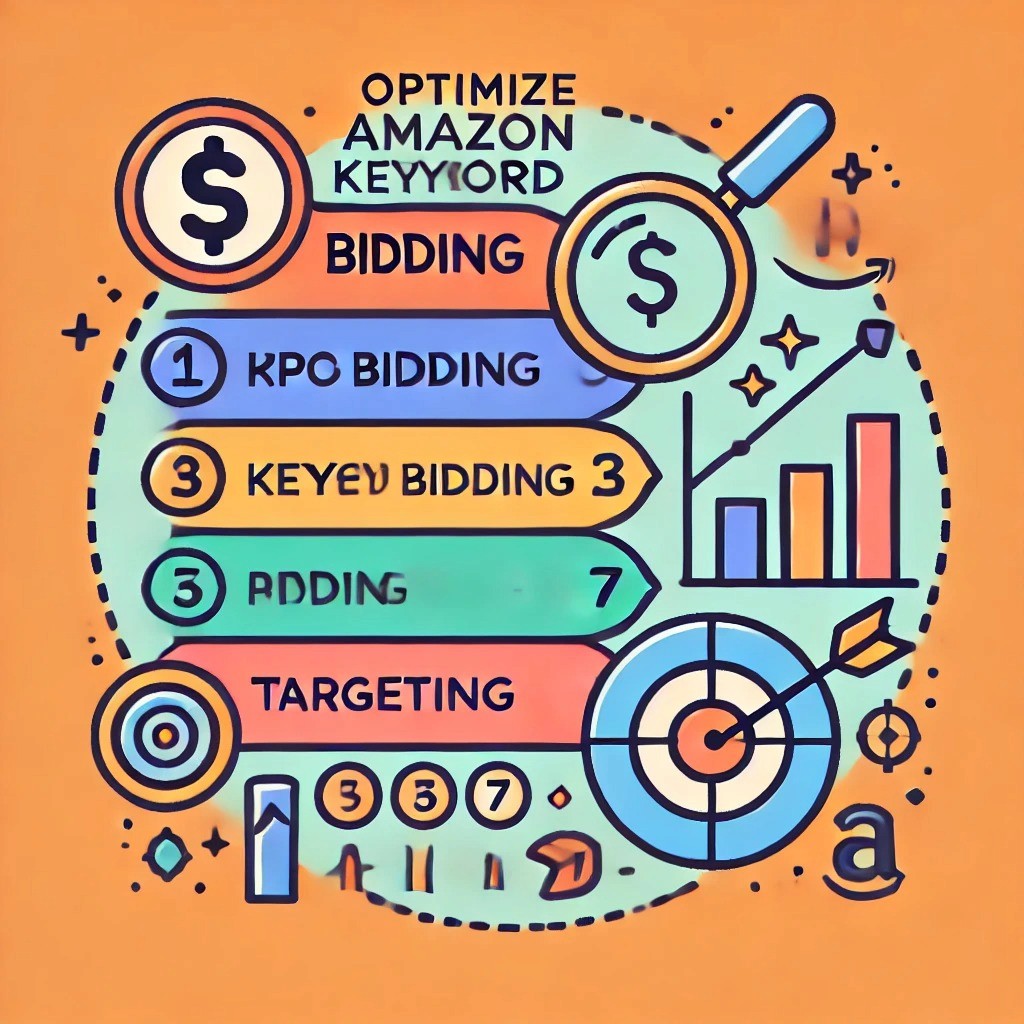

Back to Page
Amazon PPC
7 Tips To Optimize Your Amazon PPC Keyword Bidding Strategy

Oct 4, 2021
Amazon CPC is constantly increasing. According to Marketplace Pulse, advertising on Amazon now costs, on average, $1.20 per click. If you want to maintain the profitability of your ad campaigns, you’ll need to up your keyword bidding strategy. We understand that there can be no one-size-fits-all strategy. Every campaign and product is unique, but a general understanding of how keywords work and how you can efficiently dial your keyword bids can impact your bottom line.
What is a keyword?
Keywords are the terms your shoppers would type in the search bar to find your product. An effective campaign should include all the keywords your customers are typing in the search bar. This includes long-tail keywords, low volume keywords, synonym keywords (for example, a bento box can also be called a lunch box), and more.
Here’s how you can get a comprehensive list of keywords:
Use Amazon keyword tools like Merchant Words & Helium10
A quick title-scan of first page competitors is a great way to target synonym keywords
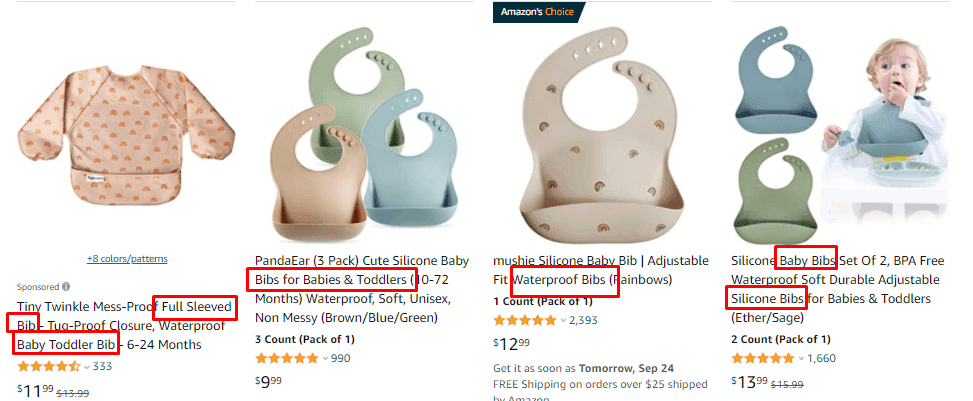
Go through the search term report to identify the exact terms your customers are using to find your product
Use Amazon’s suggestion to get a list of long tail keywords
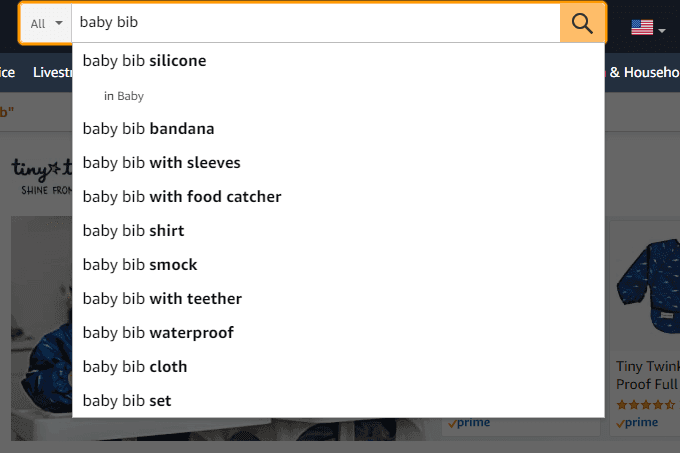
Tips to improve your Amazon keyword bidding strategy
#1: Identify the bid type that works best for your brand
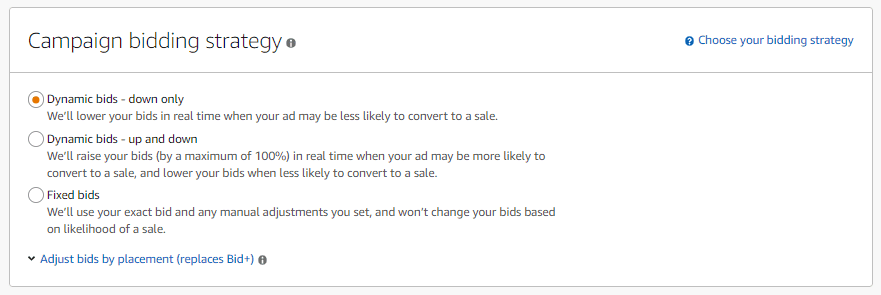
For efficient bid adjustment, Amazon has introduced three bid types:
Down-only bid: Amazon will automatically lower the bid when your ad is less likely to convert.
Up & down bid: Amazon will automatically raise your bid (by a maximum of 100%) when an ad is more likely to convert and lower your bid when your ad is less likely to convert.
Fixed bid: Amazon will use the exact bid you’ve set.
The best way to find out which bidding strategy works best for your brand is by using each of the bid types for the same campaign and identifying which bid types align with your goals.
#2: Target & bid on keywords with low volume
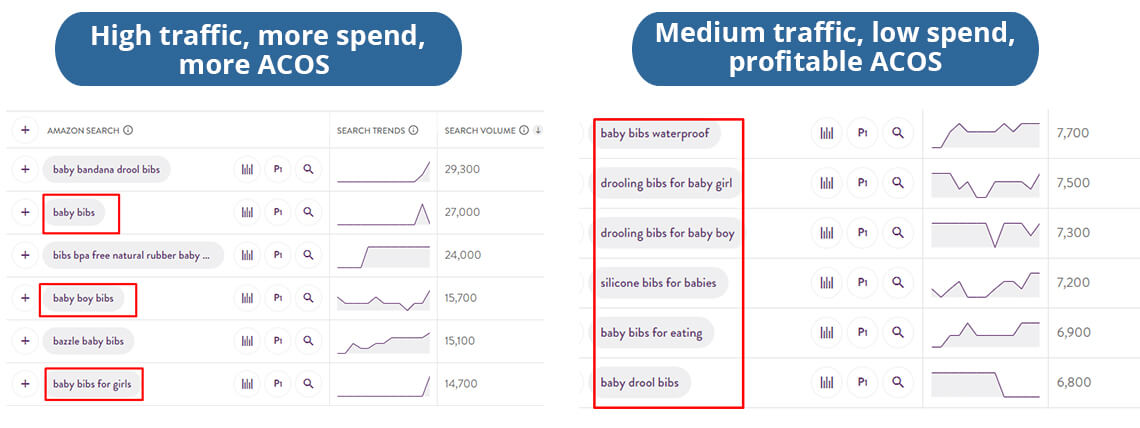
Every advertiser wants to rank on high-volume keywords but not everyone can rank on high-volume search terms. Besides, as these keywords are super competitive, the bids and CPC are always sky-high. What should you do if you’ve just started or don’t have the budget to spend on high-volume, competitive keywords? Use low volume, long-tail keywords for your campaigns. Although long-tail keywords bring in less traffic to your detail page, they’re more likely to convert and have comparatively low competition which means low spend, low ACOS maximum profitability.
#3: Avoid bidding on expensive keywords
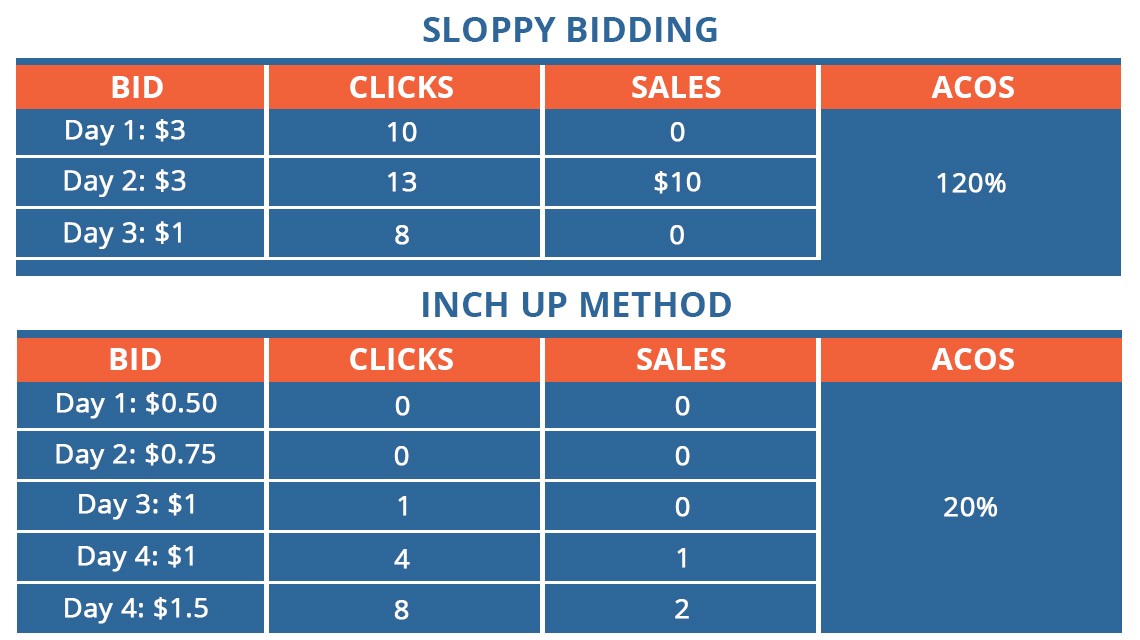
The monthly search volume for “shoes” may have more than a million searches a month but searches for “white sports shoes for men” might be less than one thousand. Because of the competition, keywords like “shoes” may cost you $7 or $10 per click with no guarantee of conversion while specific keywords like “white sports shoes for men” have lower CPC bids and better chances of converting to sales. Identifying and weeding out the “expensive” keywords from your campaigns can help you improve your cost-per-conversion rate and ultimately the profitability of your PPC campaigns.
#4: A/B test different placements
Top-of-the-page placement sure sounds nice but it’s not always profitable. Advertisers throw money to rank in the top position thinking that the higher their products are up in the results, the better they’ll perform. But that’s not true. You may find that the middle of the page and bottom of the page are more cost-effective and bring in just as many sales as top-of-the-page placements. Although the top of the placement will get you more traffic, it does not always guarantee more sales. While the bottom of the placement will get you comparatively less traffic, each customer you will get will cost you less.
#5: Increase your bids slowly and gradually
Let’s say Barry just launched a new keyword. Now he doesn’t know what the bid should be - $1, $2, $3, $4 or $10? Barry does not have any information to determine the correct bid. He saw Amazon’s suggested bid was $2 and set the bid rate at $3, thinking that it would get a lot of clicks and sales. Barry came back after 2 days and saw that the keyword ended up with 24 clicks, only one conversion, and a very high ACOS. Barry freaked out and reduced the bid to $1. The issue with this type of bidding is that when you do this for hundreds of keywords, you’ll end up with a very high ACOS and near-zero profitability.
When you’re not sure what the bid should be for a particular keyword, use the inch-up method. Set the keyword bid at $0.50 for Day 1, $0.75 for Day 2, and $1 for Day 3. You will notice no impressions or clicks on the first few days but gradually gain momentum and finally, when you get a sale, the ACOS won’t be crazy high. The inch-up method, although it gives results slowly, helps you save a lot of money in the long term.
#6: Stay updated with the current trends

Keeping a tab on your competitor’s activities is imperative to a successful keyword bidding strategy. If your CPCs have gone up, it might be because some new competitors have entered the market. To keep up, you should increase your keyword bid to maintain visibility. If the CPCs have gone down, it means that all other players in your category have lowered their bids and you should too.
#7: Optimize every day

This is not the first time you might be hearing this but it is true. PPC is not a set-it-and-forget-it thing. A profitable keyword bidding strategy includes everyday monitoring and micro-level Amazon PPC optimization of keywords, bids, budget, and more. Constantly review and make changes in the campaigns till you get the desired results. The only way you can put your PPC campaigns in auto-pilot mode is by hiring expert Amazon marketing consultants. With us, you can rest easy knowing that our Amazon consultants are constantly optimizing and scaling to ensure your campaigns run hot 24/7.
Amazon CPC is constantly increasing. According to Marketplace Pulse, advertising on Amazon now costs, on average, $1.20 per click. If you want to maintain the profitability of your ad campaigns, you’ll need to up your keyword bidding strategy. We understand that there can be no one-size-fits-all strategy. Every campaign and product is unique, but a general understanding of how keywords work and how you can efficiently dial your keyword bids can impact your bottom line.
What is a keyword?
Keywords are the terms your shoppers would type in the search bar to find your product. An effective campaign should include all the keywords your customers are typing in the search bar. This includes long-tail keywords, low volume keywords, synonym keywords (for example, a bento box can also be called a lunch box), and more.
Here’s how you can get a comprehensive list of keywords:
Use Amazon keyword tools like Merchant Words & Helium10
A quick title-scan of first page competitors is a great way to target synonym keywords

Go through the search term report to identify the exact terms your customers are using to find your product
Use Amazon’s suggestion to get a list of long tail keywords

Tips to improve your Amazon keyword bidding strategy
#1: Identify the bid type that works best for your brand

For efficient bid adjustment, Amazon has introduced three bid types:
Down-only bid: Amazon will automatically lower the bid when your ad is less likely to convert.
Up & down bid: Amazon will automatically raise your bid (by a maximum of 100%) when an ad is more likely to convert and lower your bid when your ad is less likely to convert.
Fixed bid: Amazon will use the exact bid you’ve set.
The best way to find out which bidding strategy works best for your brand is by using each of the bid types for the same campaign and identifying which bid types align with your goals.
#2: Target & bid on keywords with low volume

Every advertiser wants to rank on high-volume keywords but not everyone can rank on high-volume search terms. Besides, as these keywords are super competitive, the bids and CPC are always sky-high. What should you do if you’ve just started or don’t have the budget to spend on high-volume, competitive keywords? Use low volume, long-tail keywords for your campaigns. Although long-tail keywords bring in less traffic to your detail page, they’re more likely to convert and have comparatively low competition which means low spend, low ACOS maximum profitability.
#3: Avoid bidding on expensive keywords

The monthly search volume for “shoes” may have more than a million searches a month but searches for “white sports shoes for men” might be less than one thousand. Because of the competition, keywords like “shoes” may cost you $7 or $10 per click with no guarantee of conversion while specific keywords like “white sports shoes for men” have lower CPC bids and better chances of converting to sales. Identifying and weeding out the “expensive” keywords from your campaigns can help you improve your cost-per-conversion rate and ultimately the profitability of your PPC campaigns.
#4: A/B test different placements
Top-of-the-page placement sure sounds nice but it’s not always profitable. Advertisers throw money to rank in the top position thinking that the higher their products are up in the results, the better they’ll perform. But that’s not true. You may find that the middle of the page and bottom of the page are more cost-effective and bring in just as many sales as top-of-the-page placements. Although the top of the placement will get you more traffic, it does not always guarantee more sales. While the bottom of the placement will get you comparatively less traffic, each customer you will get will cost you less.
#5: Increase your bids slowly and gradually
Let’s say Barry just launched a new keyword. Now he doesn’t know what the bid should be - $1, $2, $3, $4 or $10? Barry does not have any information to determine the correct bid. He saw Amazon’s suggested bid was $2 and set the bid rate at $3, thinking that it would get a lot of clicks and sales. Barry came back after 2 days and saw that the keyword ended up with 24 clicks, only one conversion, and a very high ACOS. Barry freaked out and reduced the bid to $1. The issue with this type of bidding is that when you do this for hundreds of keywords, you’ll end up with a very high ACOS and near-zero profitability.
When you’re not sure what the bid should be for a particular keyword, use the inch-up method. Set the keyword bid at $0.50 for Day 1, $0.75 for Day 2, and $1 for Day 3. You will notice no impressions or clicks on the first few days but gradually gain momentum and finally, when you get a sale, the ACOS won’t be crazy high. The inch-up method, although it gives results slowly, helps you save a lot of money in the long term.
#6: Stay updated with the current trends

Keeping a tab on your competitor’s activities is imperative to a successful keyword bidding strategy. If your CPCs have gone up, it might be because some new competitors have entered the market. To keep up, you should increase your keyword bid to maintain visibility. If the CPCs have gone down, it means that all other players in your category have lowered their bids and you should too.
#7: Optimize every day

This is not the first time you might be hearing this but it is true. PPC is not a set-it-and-forget-it thing. A profitable keyword bidding strategy includes everyday monitoring and micro-level Amazon PPC optimization of keywords, bids, budget, and more. Constantly review and make changes in the campaigns till you get the desired results. The only way you can put your PPC campaigns in auto-pilot mode is by hiring expert Amazon marketing consultants. With us, you can rest easy knowing that our Amazon consultants are constantly optimizing and scaling to ensure your campaigns run hot 24/7.
Amazon CPC is constantly increasing. According to Marketplace Pulse, advertising on Amazon now costs, on average, $1.20 per click. If you want to maintain the profitability of your ad campaigns, you’ll need to up your keyword bidding strategy. We understand that there can be no one-size-fits-all strategy. Every campaign and product is unique, but a general understanding of how keywords work and how you can efficiently dial your keyword bids can impact your bottom line.
What is a keyword?
Keywords are the terms your shoppers would type in the search bar to find your product. An effective campaign should include all the keywords your customers are typing in the search bar. This includes long-tail keywords, low volume keywords, synonym keywords (for example, a bento box can also be called a lunch box), and more.
Here’s how you can get a comprehensive list of keywords:
Use Amazon keyword tools like Merchant Words & Helium10
A quick title-scan of first page competitors is a great way to target synonym keywords

Go through the search term report to identify the exact terms your customers are using to find your product
Use Amazon’s suggestion to get a list of long tail keywords

Tips to improve your Amazon keyword bidding strategy
#1: Identify the bid type that works best for your brand

For efficient bid adjustment, Amazon has introduced three bid types:
Down-only bid: Amazon will automatically lower the bid when your ad is less likely to convert.
Up & down bid: Amazon will automatically raise your bid (by a maximum of 100%) when an ad is more likely to convert and lower your bid when your ad is less likely to convert.
Fixed bid: Amazon will use the exact bid you’ve set.
The best way to find out which bidding strategy works best for your brand is by using each of the bid types for the same campaign and identifying which bid types align with your goals.
#2: Target & bid on keywords with low volume

Every advertiser wants to rank on high-volume keywords but not everyone can rank on high-volume search terms. Besides, as these keywords are super competitive, the bids and CPC are always sky-high. What should you do if you’ve just started or don’t have the budget to spend on high-volume, competitive keywords? Use low volume, long-tail keywords for your campaigns. Although long-tail keywords bring in less traffic to your detail page, they’re more likely to convert and have comparatively low competition which means low spend, low ACOS maximum profitability.
#3: Avoid bidding on expensive keywords

The monthly search volume for “shoes” may have more than a million searches a month but searches for “white sports shoes for men” might be less than one thousand. Because of the competition, keywords like “shoes” may cost you $7 or $10 per click with no guarantee of conversion while specific keywords like “white sports shoes for men” have lower CPC bids and better chances of converting to sales. Identifying and weeding out the “expensive” keywords from your campaigns can help you improve your cost-per-conversion rate and ultimately the profitability of your PPC campaigns.
#4: A/B test different placements
Top-of-the-page placement sure sounds nice but it’s not always profitable. Advertisers throw money to rank in the top position thinking that the higher their products are up in the results, the better they’ll perform. But that’s not true. You may find that the middle of the page and bottom of the page are more cost-effective and bring in just as many sales as top-of-the-page placements. Although the top of the placement will get you more traffic, it does not always guarantee more sales. While the bottom of the placement will get you comparatively less traffic, each customer you will get will cost you less.
#5: Increase your bids slowly and gradually
Let’s say Barry just launched a new keyword. Now he doesn’t know what the bid should be - $1, $2, $3, $4 or $10? Barry does not have any information to determine the correct bid. He saw Amazon’s suggested bid was $2 and set the bid rate at $3, thinking that it would get a lot of clicks and sales. Barry came back after 2 days and saw that the keyword ended up with 24 clicks, only one conversion, and a very high ACOS. Barry freaked out and reduced the bid to $1. The issue with this type of bidding is that when you do this for hundreds of keywords, you’ll end up with a very high ACOS and near-zero profitability.
When you’re not sure what the bid should be for a particular keyword, use the inch-up method. Set the keyword bid at $0.50 for Day 1, $0.75 for Day 2, and $1 for Day 3. You will notice no impressions or clicks on the first few days but gradually gain momentum and finally, when you get a sale, the ACOS won’t be crazy high. The inch-up method, although it gives results slowly, helps you save a lot of money in the long term.
#6: Stay updated with the current trends

Keeping a tab on your competitor’s activities is imperative to a successful keyword bidding strategy. If your CPCs have gone up, it might be because some new competitors have entered the market. To keep up, you should increase your keyword bid to maintain visibility. If the CPCs have gone down, it means that all other players in your category have lowered their bids and you should too.
#7: Optimize every day

This is not the first time you might be hearing this but it is true. PPC is not a set-it-and-forget-it thing. A profitable keyword bidding strategy includes everyday monitoring and micro-level Amazon PPC optimization of keywords, bids, budget, and more. Constantly review and make changes in the campaigns till you get the desired results. The only way you can put your PPC campaigns in auto-pilot mode is by hiring expert Amazon marketing consultants. With us, you can rest easy knowing that our Amazon consultants are constantly optimizing and scaling to ensure your campaigns run hot 24/7.









